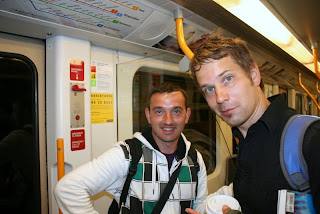 |
| Kip and me in The Hiding Place |
I have both looked forward to and postponed writing about our 23 hour layover in Amsterdam. Like most of this trip, it was fun and challenging and deeply touching spiritually. I am almost afraid of slighting it by summarizing it in a few short paragraphs, but I don’t want to miss the opportunity to blog on it either.
So even though it has been a month ago now, I’ll try.
On the way back from Norway we stopped in Amsterdam. When we booked our tickets we could schedule anything from a 1 to 23 hour layover. Since we had never been to Amsterdam we picked the longest possible layover and decided to take in as much of the city as we could.
We found a cheap little hotel, a block away from the central train station. To maximize time, we checked our bags through to Los Angeles and just took my backpack. I had basic personal items, a change of clothes and my camera. Perfect.
After stopping by the hotel and dropping the backpacks, we got back on the train and headed out to Haarlem to visit the BeJe, the museum of Corrie Ten Boom's home. I felt bad insisting that we leave Amsterdam as soon as we arrived, but it was the ONE thing I wanted to see in the Netherlands.
Corrie's Story
Of all the real-life stories I heard growing up, nothing shaped my life as much as the story of Corrie Ten Boom, a middle-aged, never-married woman who chose to defy Nazi German occupation and hide Jewish people in her home.
She was an unlikely leader in the Dutch underground, a deeply religious woman who lived a quite life at home with her elderly father and spinster sister. But in the time of crisis they did what they had always done, loved their neighbors and offered hospitality to God's chosen people, "the apple of God's eye," until the day the Gestapo raided the house, searching it down to the floorboards.
Although the Nazi’s spent the entire day searching and interrogating the family, they never discovered the six refuges hiding in a special shelter behind Corrie’s bedroom wall.
 |
| Six people hid here for two and a half days while Nazis searched the home. |
They did, however, find stolen ration cards. For this offense they arrested the entire family as well as several of their friends who were helping them. Corrie’s 84-year-old father died in prison and Corrie and her 59-year-old sister were sent to a harsh concentration camp in Germany. The work camp housed 50,000 political prisoners who built roads all day and were barely fed or clothed against the elements. Corrie’s sister died in the camp and Corrie only escaped after the guards mistakenly released her the day before they mass murdered all the middle-aged prisoners.
Through the entire ordeal, Corrie and her sister had one message: love and forgiveness. They shared God’s love with fellow prisoners and made their bunker a haven from the Hell around them. They preached love, including love for the guards who were mistreating them. After the war Corrie opened her empty house to people who had been displaced and needed somewhere to recover. Her guests included Dutch people who had betrayed their countrymen and cooperated with the Germans.
Then at 53 years old, Corrie began traveling the world, telling her story. She continued for the next 30 years during which time my parents heard her story.
One of the stories that I heard growing up was about how, during a speaking engagement, Corrie met one of the notoriously cruel prison guards who had beaten her and her sister. The woman stretched out her hand and asked Corrie to forgive her. It was a real test for Corrie, but she chose in that moment to forgive the guard. As she embraced her, God filled Corrie with forgiveness and love toward the guard.
There were several books written about Corrie including the Hiding Place
And so when I realized our Norway travels would take us through Amsterdam, I didn't want to miss the opportunity to go to the BeJe and see the actual hiding place.
The BeJe
Kip and I were the only people for the English speaking tour. We stood sheepishly in the alley outside the house and waited for someone to open the door. An elderly woman who had known Corrie personally greeted us in her own formal way. She took us into the parlor where she told us the story in her thick Dutch accent.
She showed us family pictures and took us on a tour of the home. More than anything I realized that it wasn’t just a story about Corrie, but an entire family who gladly sacrificed everything to do what was right.
 | ||
| Betsy, our tour guide, and me |
It was Corrie’s message living on.



















































